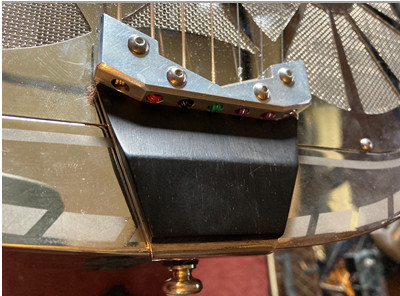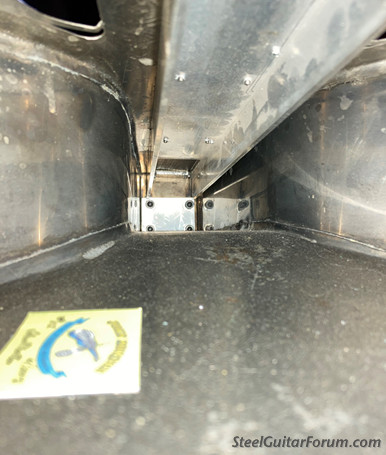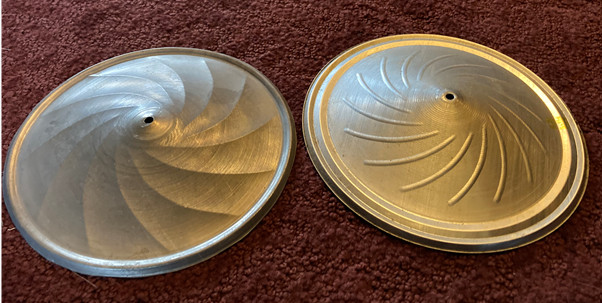The tricones:
1) A borrowed Chinese factory made Regal RC-51 with a round neck and nut-raiser for playing across the lap. It looks like most every other tricone out there and is strung up in Open D (D A D F# A D).
2) An USA handmade custom 7-string Morton, tuned to D6 (D A D F# A B D)

What they have in common:
- bell brass bodies
- 6” cones
Exterior physical differences:
- 6 strings VS 7 strings
- traditional cone arrangement VS symmetrical cone arrangement
- Chinese made cones VS Morton-made and National cones
- scale length: 25.5” VS 23”
- body depth: 3” VS 4.25”
- neck: solid wood VS hollow metal
- headstock: wood vs solid milled metal (aluminum?)
- tailpiece: typical tricone tailpiece of lightweight stamped metal VS short and heavy, metal and ebony.
- bridge wood thicknesses: thin vs thick


Internal differences:
- wood support running the length of the body, screwed to the pan and braced against the back by three posts VS completely hollow with a metal (aluminum?) channel running under the fretboard
- Typical pan with contours and indentions surrounding the cones VS completely smooth with a support post that runs up both sides of the bridge and supports the cover plate. This support does not protrude below the pan. This may be the reason the Morton doesn’t rattle. When the Regal rattles, I move the bridge around a bit and it usually solves it. The rattles probably come from the side of the cones touching the contours.
- Screen brazed to the cover plate VS glued.





NOTE: The Morton cones were darker and the volume noticeably suffered. I put the Chinese cones in the Morton and it instantly improved everything. So, I ordered a set of Nationals which are even better. Also, the Mortons are about 1/8” shorter which made the bridge lower than the nut. The National cones are staying and all of the below tests are with them in place.

Sound:
- sustain: The regal sustains a bit longer and it’s really noticeable when I test it with the pinky harmonic Sleepwalk lick. The Regal can sustain all the way through the lick where the Morton loses sustain at the 12th fret and can’t quite make the final descent back to the 7th fret with convincing volume. Curiously, the Morton is much closer to the Regal if I play above or below the 12th fret. Something about the 12th fret seems to dampen the sustain. Is this about the lack of internal bracing and shorter scale length?
- Volume: I had to switch back and forth several times to make a determination. The Regal is a bit louder but my ear might be mistaking tone for volume. See below
- Tone: The Regal is more rough and metallic. I didn’t think it was “plain” until I compared them both. The Morton is smoother and richer. This is somewhat subjective, but when I play them both over the neck, the Morton instantly mellows out and sounds “Hawaiian”. It’s a dramatic change from playing near the bridge. The Regal sounds different when playing over the neck instead of near the bridge, of course, but it still sounds kinda the same. Rough and metallic with the same crisp attack.
- Resonance/ambiance: The Morton easily wins this one. It might be the lack of internal supports and deeper body but the natural “reverb” of the Morton is both larger and more pleasant to my ears.
Other:
- I can do interesting harmonic things with the Morton. For example, I can lift my fingers from behind the bar, play a note at the 7th fret and slide down to the 5th or 3rd, apply fast vibrato to get a very audible harmonic “whistle”. I can pluck behind the bar, high up the neck and slide down to the 12th where the volume will suddenly jump out at you. When the Morton’s sustain starts to die the harmonic lingers so I can slide it around. The Regal can do all of the above to a degree but it’s much more subtle.